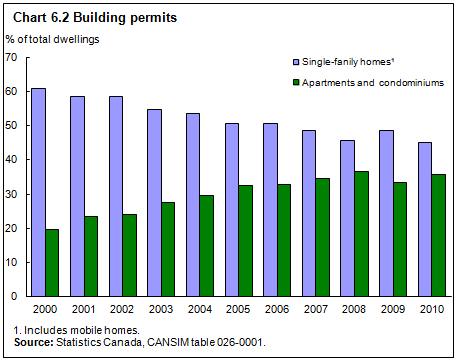Canadian cities are growing
Archived Content
Information identified as archived is provided for reference, research or recordkeeping purposes. It is not subject to the Government of Canada Web Standards and has not been altered or updated since it was archived. Please "contact us" to request a format other than those available.
Related information
Canadian cities are not only growing out, they're growing up. Builders are adapting to land shortages and to the evolving lifestyles of Canadians by building more apartments and condominiums, maximizing the use of available space.
During the 2000s, a growing share of construction was devoted to apartments and condominiums. In 2000, they accounted for 20.1% of residential construction. By 2008, 37.0% of residential construction was dedicated to apartments and condominiums. However, this trend reversed slightly in 2009 and 2010, slipping to 33.5% and 35.7%, respectively.
The growing share of apartments and condominiums is more obvious in Canada's largest cities. In 1991, 90% of all condominiums were located in the country's 25 largest cities. Today, the largest cities continue to see the greatest growth in high-density residential construction. In 2010, the share of residential construction accounted for by apartments and condominiums was 55.6% in Montréal and 49.9% in Toronto. Apartment and condominium development in Vancouver increased to 50.7%, well above the national average (35.7%).
- Date modified:

